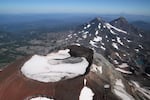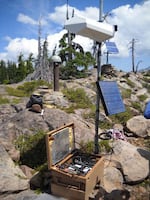
An aerial view from the south of South Sister, Middle Sister and North Sister in Oregon's Cascade Range.
Courtesy of U.S. Geological Survey / John Scurlock
Scientists are seeing new signs that magma is moving deep within the Three Sisters volcanic complex in Oregon’s Cascade Range.
Equipment used by the U.S. Geological Survey to monitor volcanic activity has detected short bursts of tiny earthquakes across a 12-mile area where the ground has been lifting at a faster pace.
Jon Major, scientist in charge at the Cascades Volcano Observatory, said the activity is likely coming from pulses of magma moving about four miles underground.
“There’s no imminent threat,” he said. “Our interpretation is it’s probably related to ongoing small inputs of magma deep underground.”
If the volcano were close to erupting, Major said, the magma would be breaking more rock, generating bigger earthquakes, releasing gases and lifting the ground at a much faster pace.
“There would be a lot more signs that magma was making its way to the surface and poised for an eruption,” he said. “We’re not seeing any of that right now.”
The last time Three Sisters erupted was about 2,200 years ago. Major said it is likely to erupt again, but the latest activity is minimal compared to what scientists expect to see before an eruption.
Over a 14-month period between June 2020 and August 2021, advanced satellite technology measured the ground lifting up a little less than an inch across a 12-mile area west of South Sister.
“Which is pretty amazing to think about,” Major said. “This is not the kind of change in the surface of the ground that you and I would stand out there and detect at all.”

A GPS station in the Three Sisters Wilderness measures seismic activity in the area.
Courtesy of U.S. Geological Survey
Major said the recent rate of uplift is not as fast as scientists saw in the region in the 1990s, when the ground lifted several inches, but it is faster than they’ve seen in the past two decades. And it’s all happening in the same general location.
“We have been monitoring volcanoes up and down the Cascades to take the pulse of anything that’s abnormal,” Major said. “That way, if we detect any abnormalities that a volcano is going into a state of unrest we pick it up as early as possible.”
New technology has allowed scientists to detect miniscule changes in the ground level and nearly undetectable seismic activity, Major said.
“These satellites are sensitive enough that they can detect very small differences between satellite and ground surfaces,” he said.
USGS also has very sensitive seismometers that detected very small earthquakes in the same area in October, December and earlier this month.
“The magnitudes are well below magnitude 1,” Major said. “They’re very small earthquakes — barely detectable.”
This kind of activity might just be normal background noise for the Three Sisters Volcanic Complex, and it might be that scientists are now able to measure because of new technology, he said.
“This process has probably been going on for a long time but we haven’t necessarily had the technology to detect this kind of thing before,” Major said.
Scientists say periods of uplift in the Three Sisters volcanic cluster are likely a continuation of episodic movements of magma that have been occurring regularly for centuries or millennia.
The complex’s three volcanoes — North Sister, Middle Sister and South Sister — were constructed between 120,000 and 50,000 years ago.
